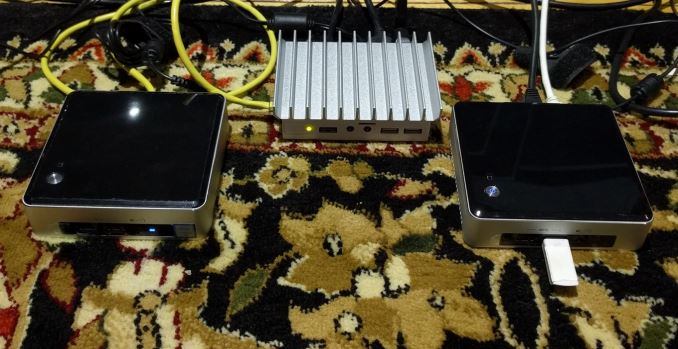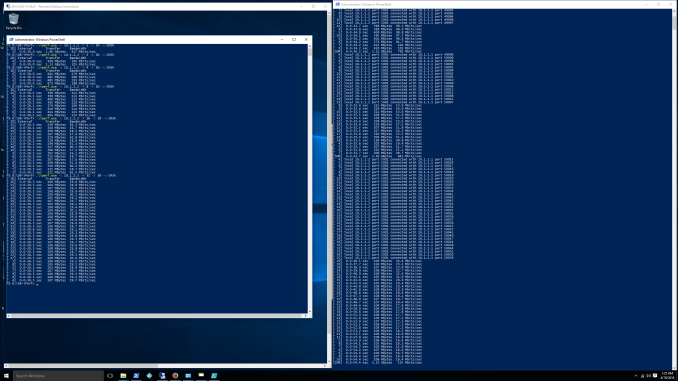Compulab fitlet-XA10-LAN Review: A Fanless AMD UCFF PC for Networking Applications
by Ganesh T S on April 19, 2016 8:00 AM EST- Posted in
- Systems
- Networking
- AMD
- Fanless
- Industrial PC
- Passive Cooling
- CompuLab
Networking Benchmarks
The configuration of the fitlet-XA10-LAN makes it ideal for use in networking applications. Typical uses include operation as a dedicated router, or a firewall appliance (using pfSense or VyOS), or even just generating network traffic for evaluation of other components in the network. Many use-cases can also be served with a standard Linux Mint installation.
Detailed benchmarking of the unit for a particular network application is beyond the scope of this review. However, we did install VyOS on the machine to test out its capabilities as a router. VyOS had no trouble recognizing the USB WLAN adapter and the four Intel NICs. We configured the unit as described in the Quick Start Guide of the official manual. eth3 was configured as the WAN interface. eth0 was configured as a LAN interface. The NAT, DHCP server, DNS forwarder and firewall policies were set up as indicated in the above guide.
Even though plenty of benchmarks can be run for this router configuration, we decided to focus on NAT throughput with the default configuration. In order to test that aspect, we configured a NUC to act as a DHCP server on its wired interface. This wired interface was connected to the WAN port of the VyOS fitlet. The NUC itself was set to a static IP (10.1.1.2) and it gave the VyOS fitlet an IP address of 10.1.1.1.
The fitlet's LAN port was connected to another NUC, and it received an IP address in the configured subnet (192.168.50.0/24). iperf was used to track throughput across the NAT, with the WAN machine acting as a server and the LAN machine acting as a client.
Since the WLAN interface of the NUCs was connected to our default network, we could log on via Remote Desktop to process the iperf commands.
In terms of performance, the fitlet-XA10-LAN was able to route a respectable 843 Mbps across the NAT in the above-mentioned configuration. The fitlet-XA10-LAN with two active LAN interfaces idled at around 9W. When routing at full rate across the two network interfaces, the power consumption peaked at around 15W.
The Intel NICs and the powerful 'unlocked' AMD SoC ensure that the fitlet-XA10-LAN is a powerful network appliance in a compact form factor.












50 Comments
View All Comments
rstuart - Tuesday, April 19, 2016 - link
The Kettop has less than 1/2 the warranty, is still bigger, doesn't have wireless, has VGA vs 2 x HDMI, 2xUSB-2 versus 3xUSB-2 + 2xUSB-3, no serial port, and no m-PCI expansion.But yeah, your right. Apart from that you are almost buying the same thing.
Lazn_W - Wednesday, April 20, 2016 - link
I guess my brief search didn't find anything quite so small.. But there are plenty of options in this arena, perhaps not quite so tiny, but if you need the wifi etc, and more horsepower.. you can get them, here is another MFG for example: http://www.amazon.com/Qotom/b/ref=bl_dp_s_web_1006...rstuart - Wednesday, April 20, 2016 - link
It's the same deal though isn't it? Your original point is there are cheaper options elsewhere, but while it's cheaper it's hardly the same thing. Good for a home router maybe - but doesn't have the ports to do much else. For a person wanting to put in in a remote office literally mega metres away and not touch it, the 1 year warranty doesn't send a good signal.As for the AMD vs Intel thing - I simply don't care. It's a bit of mystery to me why anybody would care. What I do care about is you load the OS on it, and it just works. They certainly do that. They've given me less compatibility headaches that any box I can remember. Even Debian stable "just works".
The one criticism I have of these CompuLab boxes is there is no TPM. TPM's are nice to have in boxes holding secure credentials in remote locations. Oh yeah and the choice of the Intel 7260 wifi module. It works wonderfully as a client, but as a master it only supports 13 stations which isn't enough.
zodiacfml - Friday, April 22, 2016 - link
I'm with you here. The size of the Compulab is impressive but for someone who is going to build and leave this in a not so nice location for human beings, the size difference is not much of an advantage for the Compulab.variab1e - Tuesday, April 19, 2016 - link
Is the J1900 going to be faster than the A10 Micro-6700T ?Lazn_W - Tuesday, April 19, 2016 - link
http://cpuboss.com/cpus/Intel-Celeron-J1900-vs-AMD...ganeshts - Tuesday, April 19, 2016 - link
That is a naive comparison. Only when we actually evaluate the *system* that the real performance comes out. Those 'bot' sites that just compare paper specifications never tell the full story.When I started the fitlet-XA10-LAN review, I was pretty sure the Braswell and Bay Trail SoCs would run circles around the A10 Micro-6700T. I was very surprised with the results - the difference lies in the thermal design - the unlocked TDP means the APU can dissipate a lot more power than what it is intended to in its target market (tablets for the A10 Micro-6700T).
So, we have the A10 Micro-6700T in the fitlet-XA10-LAN that was faster than any Braswell or Bay Trail passively cooled CPU with a larger form factor in *CPU* benchmarks. Credit to Compulab should be given when they deserve it :)
Lazn_W - Tuesday, April 19, 2016 - link
Sure, I was pointing out other options for those of us who prefer the blue team.And if you are willing to spend, there are Core i5/i7 based options out there too. If interested, look on Amazon.
WorBlux - Thursday, March 9, 2017 - link
And do they come with a standard 60 month (5 whole years) warranty?Bob Todd - Tuesday, April 19, 2016 - link
I'm surprised this thing wasn't able to NAT another ~100Mb/s. A $99 ERL can max out a gigabit FTTH connection.